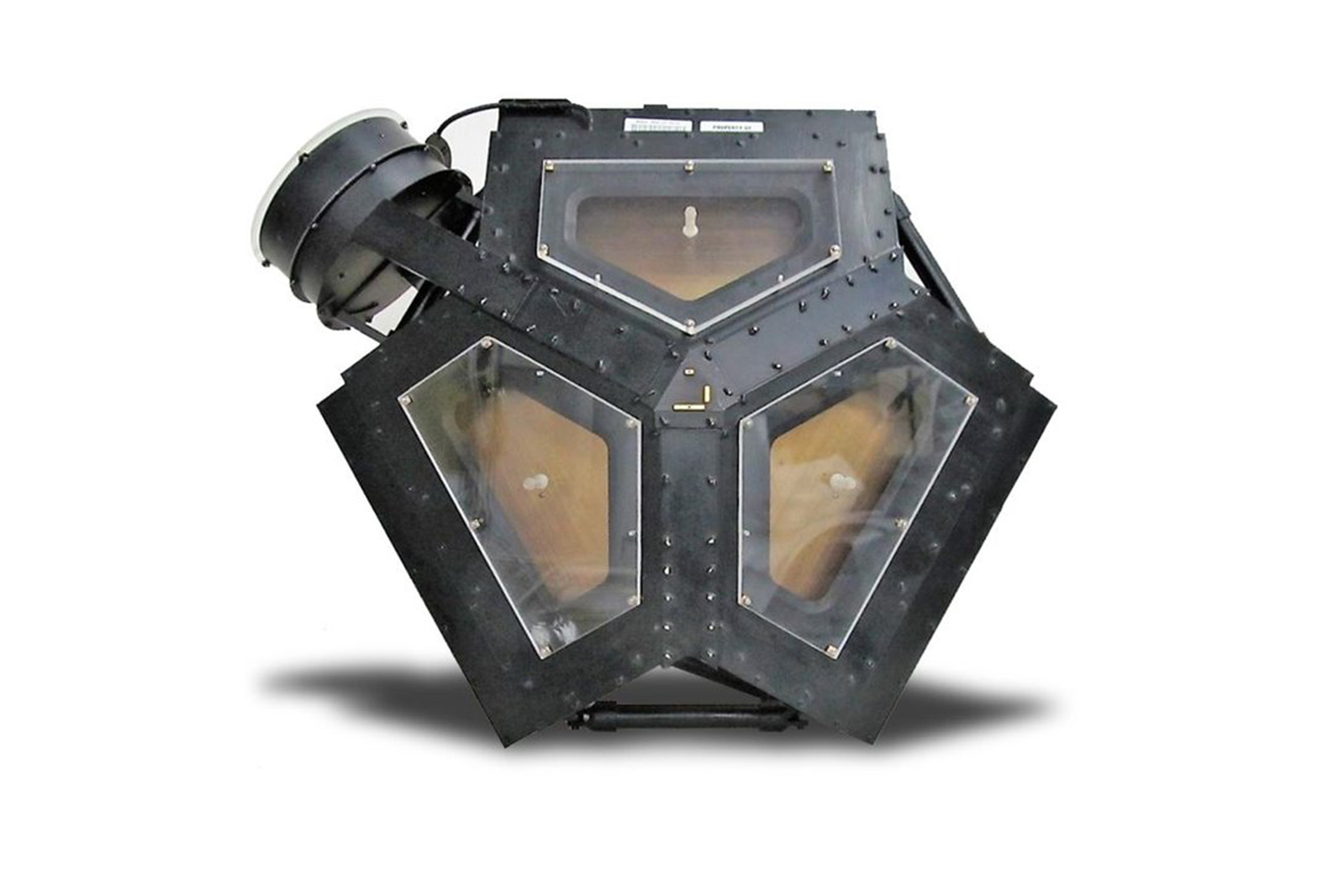
They planned to fly for four years and to get as far as Jupiter and Saturn. But nearly half a century and 15 billion miles later, NASA’s twin Voyager spacecraft have far exceeded their original mission, winging past the outer planets and busting out of our heliosphere, beyond the influence of the sun. The probes are currently making their way through interstellar space, traveling farther than any human-made object.
Along their improbable journey, the Voyagers made first-of-their-kind observations at all four giant outer planets and their moons using only a handful of instruments, including MIT’s Plasma Science Experiments — identical plasma sensors that were designed and built in the 1970s in Building 37 by MIT scientists and engineers.
The Plasma Science Experiment (also known as the Plasma Spectrometer, or PLS for short) measured charged particles in planetary magnetospheres, the solar wind, and the interstellar medium, the material between stars. Since launching on the Voyager 2 spacecraft in 1977, the PLS has revealed new phenomena near all the outer planets and in the solar wind across the solar system. The experiment played a crucial role in confirming the moment when Voyager 2 crossed the heliosphere and moved outside of the sun’s regime, into interstellar space.
Now, to conserve the little power left on Voyager 2 and prolong the mission’s life, the Voyager scientists and engineers have made the decision to shut off MIT’s Plasma Science Experiment. It’s the first in a line of science instruments that will progressively blink off over the coming years. On Sept. 26, the Voyager 2 PLS sent its last communication from 12.7 billion miles away, before it received the command to shut down.
MIT News spoke with John Belcher, the Class of 1922 Professor of Physics at MIT, who was a member of the original team that designed and built the plasma spectrometers, and John Richardson, principal research scientist at MIT’s Kavli Institute for Astrophysics and Space Research, who is the experiment’s principal investigator. Both Belcher and Richardson offered their reflections on the retirement of this interstellar piece of MIT history.
Q: Looking back at the experiment’s contributions, what are the greatest hits, in terms of what MIT’s Plasma Spectrometer has revealed about the solar system and interstellar space?
Richardson: A key PLS finding at Jupiter was the discovery of the Io torus, a plasma donut surrounding Jupiter, formed from sulphur and oxygen from Io’s volcanos (which were discovered in Voyager images). At Saturn, PLS found a magnetosphere full of water and oxygen that had been knocked off of Saturn’s icy moons. At Uranus and Neptune, the tilt of the magnetic fields led to PLS seeing smaller density features, with Uranus’ plasma disappearing near the planet. Another key PLS observation was of the termination shock, which was the first observation of the plasma at the largest shock in the solar system, where the solar wind stopped being supersonic. This boundary had a huge drop in speed and an increase in the density and temperature of the solar wind. And finally, PLS documented Voyager 2’s crossing of the heliopause by detecting a stopping of outward-flowing plasma. This signaled the end of the solar wind and the beginning of the local interstellar medium (LISM). Although not designed to measure the LISM, PLS constantly measured the interstellar plasma currents beyond the heliosphere. It is very sad to lose this instrument and data!
Belcher: It is important to emphasize that PLS was the result of decades of development by MIT Professor Herbert Bridge (1919-1995) and Alan Lazarus (1931-2014). The first version of the instrument they designed was flown on Explorer 10 in 1961. And the most recent version is flying on the Solar Probe, which is collecting measurements very close to the sun to understand the origins of solar wind. Bridge was the principal investigator for plasma probes on spacecraft which visited the sun and every major planetary body in the solar system.
Q: During their tenure aboard the Voyager probes, how did the plasma sensors do their job over the last 47 years?
Richardson: There were four Faraday cup detectors designed by Herb Bridge that measured currents from ions and electrons that entered the detectors. By measuring these particles at different energies, we could find the plasma velocity, density, and temperature in the solar wind and in the four planetary magnetospheres Voyager encountered. Voyager data were (and are still) sent to Earth every day and received by NASA’s deep space network of antennae. Keeping two 1970s-era spacecraft going for 47 years and counting has been an amazing feat of JPL engineering prowess — you can google the most recent rescue when Voyager 1 lost some memory in November of 2023 and stopped sending data. JPL figured out the problem and was able to reprogram the flight data system from 15 billion miles away, and all is back to normal now. Shutting down PLS involves sending a command which will get to Voyager 2 about 19 hours later, providing the rest of the spacecraft enough power to continue.
Q: Once the plasma sensors have shut down, how much more could Voyager do, and how far might it still go?
Richardson: Voyager will still measure the galactic cosmic rays, magnetic fields, and plasma waves. The available power decreases about 4 watts per year as the plutonium which powers them decays. We hope to keep some of the instruments running until the mid-2030s, but that will be a challenge as power levels decrease.
Belcher: Nick Oberg at the Kapteyn Astronomical Institute in the Netherlands has made an exhaustive study of the future of the spacecraft, using data from the European Space Agency’s spacecraft Gaia. In about 30,000 years, the spacecraft will reach the distance to the nearest stars. Because space is so vast, there is zero chance that the spacecraft will collide directly with a star in the lifetime of the universe. However, the spacecraft surface will erode by microcollisions with vast clouds of interstellar dust, but this happens very slowly.
In Oberg’s estimate, the Golden Records [identical records that were placed aboard each probe, that contain selected sounds and images to represent life on Earth] are likely to survive for a span of over 5 billion years. After those 5 billion years, things are difficult to predict, since at this point, the Milky Way will collide with its massive neighbor, the Andromeda galaxy. During this collision, there is a one in five chance that the spacecraft will be flung into the intergalactic medium, where there is little dust and little weathering. In that case, it is possible that the spacecraft will survive for trillions of years. A trillion years is about 100 times the current age of the universe. The Earth ceases to exist in about 6 billion years, when the sun enters its red giant phase and engulfs it.
In a “poor man’s” version of the Golden Record, Robert Butler, the chief engineer of the Plasma Instrument, inscribed the names of the MIT engineers and scientists who had worked on the spacecraft on the collector plate of the side-looking cup. Butler’s home state was New Hampshire, and he put the state motto, “Live Free or Die,” at the top of the list of names. Thanks to Butler, although New Hampshire will not survive for a trillion years, its state motto might. The flight spare of the PLS instrument is now displayed at the MIT Museum, where you can see the text of Butler’s message by peering into the side-looking sensor.






